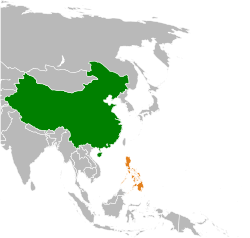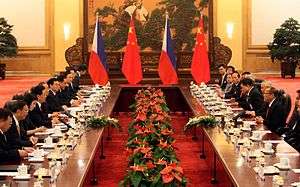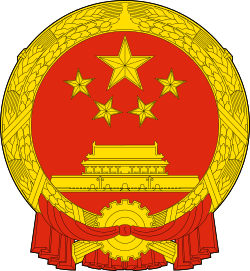China–Philippines relations
 |
|
China |
Philippines |
|---|---|
The China–Philippines relations (Chinese: 中菲关系; pinyin: Zhōng fēi guānxì; Filipino: Ugnayang Tsina at Pilipinas) refers to the bilateral relations between the China and the Philippines. Relations between the two countries gradually improved over the years since the initiative of Philippine President Ferdinand Marcos. However, relations between the two countries have suffered due to the worsening South China Sea dispute. The current president of the Philippines, Rodrigo Duterte, aims at remedying relations between the Philippines and China at the expense of the former's relationship with the United States.[1]
Several major bilateral agreements were signed between the two countries over the years, such as: Joint Trade Agreement (1975); Scientific and Technological Cooperation Agreement (1978); Postal Agreement (1978); Air Services Agreement (1979); Visiting Forces Agreement (1999); Cultural Agreement (1979); Investment Promotion and Protection Agreement (1992); Agreement on Agricultural Cooperation (1999); Tax Agreement (1999); and Treaty on Mutual Judicial Assistance on Criminal Matters (2000). In May 2000, on the eve of the 25th anniversary of their diplomatic relations, the two countries signed a Joint Statement defining the framework of bilateral relations in the 21st century. Bilateral relations between the Philippines and China have significantly progressed in recent years. The growing bilateral relations were highlighted by the state visit to China of Philippine President Gloria Macapagal-Arroyo on 29–31 October 2001. During the visit, President Arroyo held bilateral talks with top Chinese leaders, namely President Jiang Zemin, NPC Chairman Li Peng, and Premier Zhu Rongji. President Arroyo also attended the 9th APEC Economic Leaders Meeting held in Shanghai on October 20–21, 2001, where she also had bilateral talks with President Jiang. During President Arroyo's visit, eight important bilateral agreements were signed.
A 2014 survey conducted by the Pew Research Center showed 93% of Filipinos were concerned that territorial disputes between China and neighbouring countries could lead to a military conflict.[2]
Political relations

Prior to the 1970s, the Philippines government maintained a close relationship with the Kuomintang-ruled Taiwan (Republic of China), and saw China (People's Republic of China) as a security threat.[3] It began considering normalizing relations with China at the start of the 1970s; the two countries established diplomatic relations on 9 June 1975 with the signing of the Joint Communiqué by leaders of the two countries. Over the 34 years, China–Philippines relations in general have attained a smooth development, and also remarkable achievements in all areas of bilateral cooperation. Since the establishment of diplomatic relations, there has been frequent exchange of high-level visits between China and the Philippines. Philippine Presidents Marcos (June 1975), Corazon Aquino (April 1988), Ramos (April 1993), Estrada (May 2000), Gloria Macapagal-Arroyo (November 2001 and September 2004), and Benigno Aquino III (August–September 2011) have visited China. Premier Li Peng (December 1990), Chairman of the Standing Committee of the 8th National People's Congress Mr. Qiao Shi (August 1993), President Jiang Zemin (November 1996), Premier Zhu Rongji (November 1999), Chairman of the Standing Committee of the 9th National People's Congress Mr. Li Peng (September 2002), Chairman of the Standing Committee of the 10th National People's Congress Mr. Wu Bangguo (August 2003), President Hu Jintao (April 2005) and Premier Wen Jiabao (January 2007) visited the Philippines. During President Jiang Zemin's state visit to the Philippines in 1996, leaders of the two countries agreed to establish a cooperative relationship based on good-neighborliness and mutual trust towards the 21st century, and reached important consensus and understanding of "Shelving disputes and going in for joint development" on the issue of South China Sea. In 2000, China and the Philippines signed the "Joint Statement Between China and the Philippines on the Framework of Bilateral Cooperation in the Twenty-First Century", which confirmed that the two sides will establish a long-term and stable relationship on the basis of good neighborliness, cooperation, mutual trust and benefit. During President Hu Jintao's state visit to the Philippines in 2005, both countries are determined to establish the strategic and cooperative relations that aim at the peace and development. During Premier Wen Jiabao's official visit to the Philippines in January 2007, both sides issued a joint statement, reaffirming the commitment of taking further steps to deepen the strategic and cooperative relationship for peace and development between the two countries.
In April 2007 President Arroyo attended the annual meeting of the Boao Forum for Asia. In June 2007 she visited Chengdu and Chongqing, and in October, she attended Shanghai Special Olympics and made a side trip to Yantai, Shandong Province. In January 2008, Speaker of the Philippine House of Representatives De Venecia visited China. In August, President Arroyo attended the opening ceremony of the Beijing Olympic Games and made a side trip to Chengdu. In October Arroyo attended the Asia-Europe Summit Meeting in China and made a side trip to Wuhan and Hangzhou. Speaker of the Philippine House of Representatives Nograles went to Nanning for the 5th China-ASEAN Expo and paid a visit to Kunming and Xiamen. Vice President De Castro attended the 9th China Western International Exposition in Chengdu. In November De Castro attended the 4th World Cities Forum in Nanjing and visited Anhui and Shanghai. In December, President Arroyo went to Hong Kong to attend the Clinton Global Initiative Forum- Asia Meeting. China's Ministry of Foreign Affairs and the Department of Foreign Affairs of the Philippines set up a consultation mechanism in 1991, and 15 rounds of diplomatic consultations have been held since then. Apart from reciprocal establishment of Embassies, China has a consulate general in Cebu, and established a consulate office in Laoag in April 2007. The Philippines have consulate generals in Xiamen, Guangzhou, Shanghai, Chongqing, Chengdu and Hong Kong.
Trade and commerce
Bilateral trade volume in 2007 was 30.62 billion USD. From January to October 2008, bilateral trade volume reached 25.3 billion USD, an increase of 1.4% as compared with the same period last year. By the end of September 2008, the actually utilized value of accumulative investment from the Philippines to China reached 2.5 billion USD. China's transformation into a major economic power in the 21st century has led to an increase of foreign investments in the bamboo network, a network of overseas Chinese businesses operating in the markets of Southeast Asia that share common family and cultural ties.[4][5]
In 1999, China's Ministry of Agriculture and the Department of Agriculture of the Philippines signed the Agreement on Strengthening Cooperation in Agriculture and Related Fields. In 2000, relevant government agencies signed an agreement whereby China offers the Philippines 100 million USD credit facility. In March 2003, China's aid project the China-Philippines Agricultural Technology Center was completed. With its successful trial planting in the Philippines, China's hybrid rice and corn have been growing over large areas in the country. In 2004, both sides signed the Memorandum of Understanding on Fisheries Cooperation. In January 2007, Chinese and Philippine Ministries of Agriculture signed Memorandum of Understanding on Broadening and Deepening Agriculture and Fisheries Cooperation.
In August 2003, the two countries signed the Memorandum of Understanding on Cooperation in Constructing the Northern Luzon Railway Project. In April 2005, the two countries signed the Memorandum of Understanding on Cooperation in the field of Infrastructure between the Ministry of Commerce of the People's Republic of China and the Department of Trade and Industry of the Republic of the Philippines.
Military exchanges
In April 2002, Philippine Secretary of Defense Reyes visited to China. In June, Philippine naval fleets visited China for the first time. In September, Chinese Vice Chairman of the Central Military Commission, State Councilor and Defense Minister Chi Haotian visited the Philippines. In 2004, Narciso Abaya, Chief of the General Staff of Philippine Armed Forces (AFP) and Secretary of Defense Avelino Cruz paid visits to China respectively, and both sides established the mechanism of annual Defense and Security Consultation. In May 2005, Xiong Guangkai, Deputy Chief of the General Staff of the Chinese People's Liberation Army (PLA) visited the Philippines and held the first Defense and Security Consultation with Philippine Defense Undersecretary Antonio Santos. In May 2006, Chief of the General Staff of AFP Gen. Denga visited China. In October, Philippine vice Secretary of Defense Santos visited China and both sides held the second round of Defense and Security Consultation. Also in October, North China Sea Fleet visited the Philippines, conducting a joint non-traditional security exercises. In May 2007, Zhang Qinsheng, Deputy Chief of the General Staff of PLA visited the Philippines and both sides held the Defense and Security Consultation for the third time. Chinese Vice Chairman of the Central Military Commission, State Councilor and Defense Minister Cao Gangchuan, paid a visit to the Philippines in September.
Bilateral Agreements
The cooperation in the fields of culture, technology, judiciary and tourism between the two countries achieves continuous progress. So far, the two sides have signed 11 two-year action plans of cultural cooperation. The joint committee of scientific and technological cooperation has held 13 sessions, during which 244 research projects have been confirmed.
The major bilateral agreements between the two countries are as follows:
Scientific and Technological Cooperation Agreement (1978), Cultural Cooperation Agreement (1979), Civil Aviation and Transportation Agreement (1979), Memorandum of Understanding on Sports Cooperation (2001), Memorandum of Understanding on Cooperation in Information Industry (2001), Memorandum of Understanding on Cooperation in the Crackdown on Transnational Crimes (2001), Treaty on Extradition (2001), Pact on Cooperation Against Illicit Traffic and Abuse of Narcotic Drugs (2001), Memorandum of Understanding on Tourism Cooperation ( 2002), Memorandum of Understanding on Maritime Cooperation(2005), Pact on Cooperation in Youth Affairs(2005), Memorandum of Understanding on Cooperation in Sanitary and Phytosanitary Cooperation(2007), Memorandum of Understanding on Education Cooperation(2007), Pact on Protection of Cultural Heritage(2007), Pact on Sanitary Cooperation(2008), etc.
Others

Chinese Filipinos constitute one group of Overseas Chinese and are one of the largest Overseas Chinese communities in Southeast Asia. As of 2005, Chinese Filipinos number approximately 1.5 million corresponding to 1.6% of the Philippine population. Chinese Filipinos are well represented in all levels of Philippine society, and well integrated politically and economically. The ethnically Chinese Filipinos comprise 1.6% (1.5 million) of the population or ~15-25% of the population including all variants of Chinese mestizos. Pure Chinese Filipinos comprise the 9th largest, and the largest non-indigenous ethnic group in the Philippines.
Chinese Filipinos are present within several commerce and business sectors in the Philippines and a few sources estimate companies which comprise a majority of the Philippine economy are owned by Chinese Filipinos, if one includes Chinese mestizos.[6][7][8][9]
In view of the ongoing territorial dispute of China and the Philippines (such as Scarborough Shoal), Chinese-Filipinos prefer a peaceful solution through diplomatic talks while some view that China should not extend its claims to other parts of South China Sea.[10]
There are 24 pairs of sister-cities or sister-provinces between China and the Philippines, namely: Hangzhou and Baguio City, Guangzhou and Manila City, Shanghai and Metro Manila, Xiamen and Cebu City, Shenyang and Quezon City, Fushun and Lipa City, Hainan and Cebu Province, Sanya and Lapu-Lapu City, Shishi and Naya City, Shandong and Ilocos Norte Province, Zibo and Manduae City, Anhui and Cavite Province, Hubei and Leyte Province, Liuzhou and Muntinlupa City, Hezhou and San Fernando City, Haerbin and Cagayan de Oro City, Laibin and Laoag City, Beijing and Manila City, Jiangxi and Bohol Province, Guangxi Zhuang Autonomous Region and Davao City, Lanzhou and Albay Province, Beihai and Puerto Princessa City, Fujian Province and Laguna Province, Wuxi and Puerto Princessa City.
The Chinese official Xinhua News Agency has its branch in Manila while CCTV-4, the Chinese international TV program, has landed in the Philippines.
Territorial disputes
The two countries have disputes over the sovereignty of some islands and shoals in the Spratly Islands. After rounds of consultations, both sides agreed to strive for a solution through bilateral friendly consultation. In October 2004, Chinese Maritime Safety Administration and Philippine Coast Guard conducted a joint sand table rescue exercise for the first time. China National Offshore Oil Corp. and Philippine National Oil Company signed the "Agreement for Joint Marine Seismic Undertaking on Certain Areas in the South China Sea" in September 1, 2004. In May 2005, Vietnam agreed to join the Sino-Philippine cooperation. Oil companies from three countries signed the "Agreement for Joint Marine Seismic Undertaking on Certain Areas in the South China Sea" in March, 2005.
Due to the 2012 Scarborough Shoal standoff, relations between the two countries have soured.[11] To the point of China having what was seen as an "underwhelming" response to disaster relief in the Philippines.[12] China later sent their Type 920 hospital ship and gave relief to assist the Philippines, though the move was small compared to other nations such as Japan, Singapore, and the United States.[13]
See also
| Wikinews has related news: Philippines seeks United Nations arbitration on South China Sea claims |
China
- List of diplomatic missions in the People's Republic of China
- List of diplomatic missions of the People's Republic of China
Philippines
- List of diplomatic missions in the Philippines
- List of diplomatic missions of the Philippines
- Cardenal, Juan Pablo; Araújo, Heriberto (2011). La silenciosa conquista china. Barcelona: Crítica. pp. 258–261. (Spanish)
References
- ↑ http://www.aljazeera.com/news/2016/10/philippines-duterte-china-announces-split-161020131226993.html
- ↑ "Chapter 4: How Asians View Each Other". Pew Research Center. Retrieved 10 October 2015.
- ↑ Zhao, Hong (2012). "Sino-Philippines Relations: Moving beyond South China Sea Dispute?". Journal of East Asian Affairs: 57. ISSN 1010-1608. Retrieved 6 March 2015 – via Questia. (subscription required (help)).
- ↑ Quinlan, Joe (November 13, 2007). "Insight: China's capital targets Asia's bamboo network". Financial Times.
- ↑ Murray L Weidenbaum (1 January 1996). The Bamboo Network: How Expatriate Chinese Entrepreneurs are Creating a New Economic Superpower in Asia. Martin Kessler Books, Free Press. pp. 4–8. ISBN 978-0-684-82289-1.
- ↑ Amy Chua, "World on Fire", 2003, Doubleday, pp. 3 & 43.
- ↑ "BW Online | December 30, 2002 | Is Democracy Dangerous?". Businessweek.com. 2002-12-30. Retrieved 2012-04-22.
- ↑ "The ethnic Chinese variable in domestic and foreign policies in Malaysia and Indonesia" (PDF). Retrieved 2012-04-23.
- ↑ Essential Outsiders: Chinese and Jews in the Modern Transformation of... - Daniel Chirot, Anthony Reid - Google Books. Retrieved 2012-05-06 – via Google Books.
- ↑ http://www.rappler.com/nation/5277-scarborough-in-the-eyes-of-chinese-filipinos
- ↑ Zirulnick, Ariel. "Philippines feels the economic cost of standing up to China." CS Monitor, 15 May 2012.
- ↑ "China urged to send warships amid Philippine aid anger". globalpost.com. Agence France-Presse. 15 November 2013. Retrieved 15 November 2013.
- ↑ Axe, David (29 November 2013). "China's Hospital Ship Helps Out in The Philippines—America's Stays Home". medium.com. War is Boring. Retrieved 29 November 2013.
External links
| Wikimedia Commons has media related to China–Philippines relations. |

